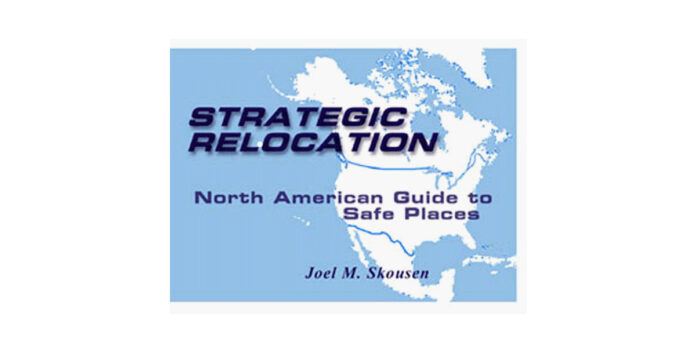About 20 years ago, I bought the book Strategic Relocation by Joel Skousen. Subtitled “North American Guide to Safe Places”, it is designed to help the reader decide where to relocate based on multiple criteria that would appeal to preppers. My copy is the first edition, printed in 1998. This book has been revised and updated, and the fourth edition, published in 2020, is now available.
This book is an excellent starting point if you are interested in leaving your crowded, dangerous urban neighborhood behind and moving somewhere that is safer and more suitable for someone looking to be more self-reliant. It covers the criteria you should consider, how to make a threat analysis and then puts it all together to rate the best parts of the country. The detailed information prior to the state rankings is useful for any prepper, even if you are not planning to move.
My point today isn’t to discuss where you should go, it’s to tell you to get moving. It took me 20 years to move to a place Joel would approve of. I doubt you have that much time. I’m not sure you have 20 months. If you’ve ever thought of moving somewhere safe, this is the time to do it. If you’ve never thought about it, give it a thought. While you are at it, put extra emphasis on looking for places that are unlikely to be nuclear targets or get lots of fallout.
Deciding to Move
My wife and I relocated two years ago after several years of looking for the perfect combination of an acceptable house in a great location. I’ve written about our plan, our want list, and our criteria in the past. I’ve also covered why we didn’t move to Idaho or Montana, despite looking at property there. If you are looking to move, our ten tips for buying a prepper property will save you hours and possibly thousands of dollars.
I found the two reasons keeping me near the city were not wanting to yank the kids from their schools and concern about how to survive financially after we moved. I think it is easiest to move kids before or after they are in high school. The financial aspects are much easier today because so many jobs can be done from home. You may be able to move two or three hours outside the city and keep your job. At some point, the desire to move while we were still young enough to enjoy our location overcame the desire to make more money.
Committing to moving to the country and becoming more independent, secure and self-sufficient is a big step. Convincing your spouse may be an even bigger ask, but it’s important you both agree before taking such a big step. Just keep in mind that when you say independent, secure and self-sufficient, they may hear, lonely, isolated and out of reach, and if you look at it from their perspective, there’s some truth to that.
What You Give Up
Strategic Relocation is all about the things you gain: Clean water, less air pollution, lower population density, lower cost of living, lower property taxes, less crime, not being near a nuclear power plant, etc. What people rarely talk about is what you give up when you move from an urban or suburban area to the boonies.
Some things we gave up were lots of restaurants; multiple grocery stores within easy reach; a wide selection of doctors, dentists and hospitals; professional and college sports, and cultural activities such as the theater, concerts, and museums. I am happy to report the only thing we miss is easy access to dentists, eye doctors, and medical specialists. Our hospital, for example, is a fine rural community hospital, but if it’s very serious, they fly you to a big city. Most specialists also require a 90 minute drive.
The good news is my wife was worried she lack social activities, but that hasn’t been the case. She’s made more friends here more quickly than she made at our last home and is involved with several organizations. We’ve found people to be very welcoming.
It’s Getting Ugly
It’s tough to notice a deterioration in our social and living conditions when things go bad slowly, just like the old frog in a pot story. If you’re reading this, you’ve probably felt the water temperature rise. The only question is, will you jump out of the pot while you still can or put it off until it’s too late?
The entire world is in bad shape. While the U.S. may be faring better than some countries, don’t think that means we are doing well. Are you going to wait until you or a loved one are a victim of violent crime before you move? How many car jackings, subway killings, and random acts of violence to you need to hear about before you leave?
I once lived in a 700-square foot apartment where I depended on trucks or pipelines for water, heat, and food. Now I have close to 20 acres, and I can walk outside at night with no worries. In the apartment, I probably could have lasted three days if services failed. Out here on our mountain, I hope to last for years.
What are you waiting for? Strategic relocation. It’s more than a book.







